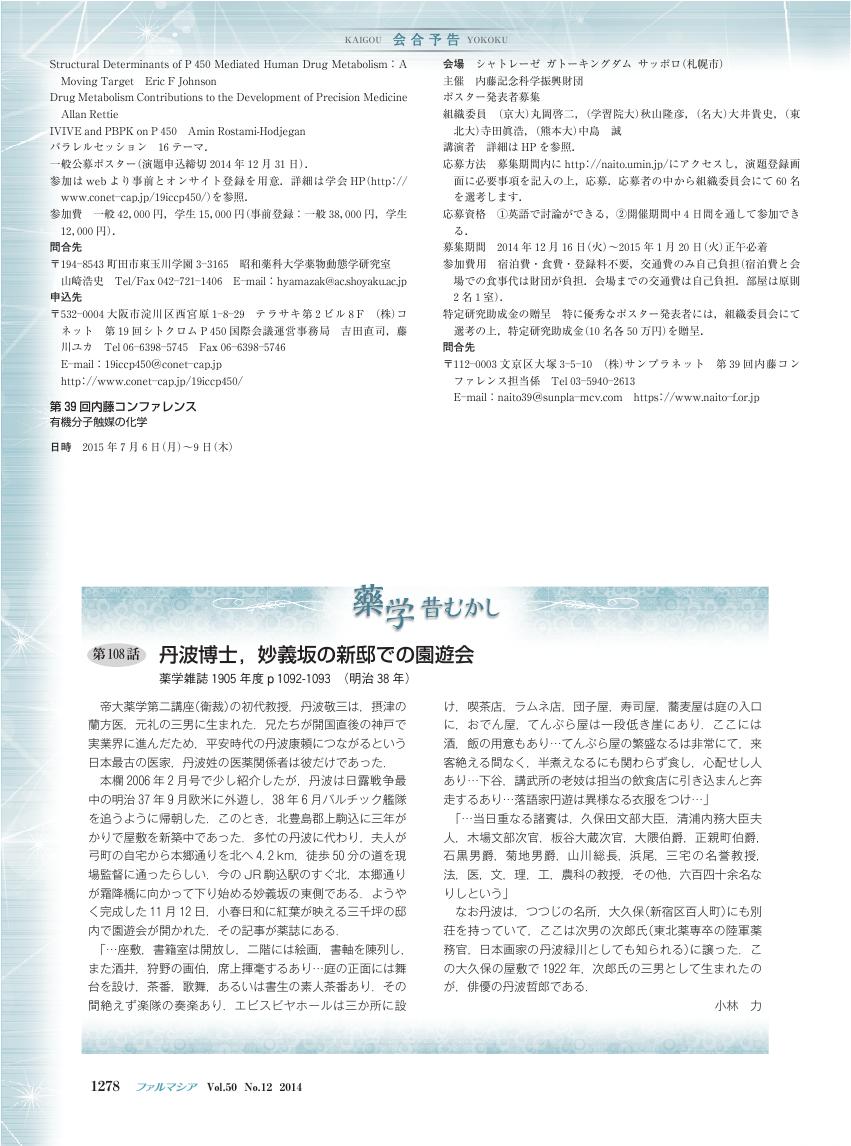8 0 0 0 OA サルファ剤の発見とその影響
- 著者
- 小林 力
- 出版者
- 日本薬史学会
- 雑誌
- 薬史学雑誌 (ISSN:02852314)
- 巻号頁・発行日
- vol.54, no.1, pp.13-18, 2019 (Released:2020-07-09)
For thousands of years, humans had sought miracle medicines. In the 1930s, people were generally the same as people today. But they were almost helpless in terms of treating bacterial infection. P. Ehrlich, watching synthetic dye molecules stain bacteria specifically and selectively, started the research for antibacterial agents, “magic bullets.” Although he failed to reach the goal, the German dye company Bayer succeeded in utilizing his concept and approach. In 1932, after screening 3,000 compounds over a four-year period, they succeeded in the development of the antibacterial red-dye compound Prontosil. This medicine was welcomed by the world as a miracle drug. In 1935, after the non-patentable derivative sulfanilamide was discovered by the Pasteur Institute, it was synthesized by many companies and spread worldwide. However, enthusiastic overuse of a medicine can cause something to go wrong. In 1937, diethylene glycol used as a solvent of Prontosil killed 105 people in the USA due to renal toxicity (i.e., Massengill elixir tragedy). In those days, toxicity data was not necessary for medicines. After this tragedy, the USA introduced a new strict law and empowered the Food and Drug Administration (FDA), and many countries followed this action. Interestingly, this regulation changed the pharmaceutical industry. In order to obtain official approval for a new drug, companies require biologists, chemists and modern laboratories to obtain safety and effectiveness data. If they are unable to do this, they must change from new-drug manufacturers to over-the-counter or supplements manufacturer. The first strong medicine also changed the relationship between doctors and patients. Before sulfa drugs, doctors knew themselves to be powerless and were humble. But after the introduction of sulfa, they became self-confident against diseases and patients. Finally, Prontosil also reduced pessimism about medicines, dissipating the prevailing attitude that chemicals would never be able to cure most diseases. Thus, new pharmaceutical companies began utilizing the Bayer method to develop innovative drugs for treating many other diseases.
- 著者
- 小林 力
- 出版者
- 日本薬学図書館協議会
- 雑誌
- 薬学図書館 = Pharmaceutical library bulletin (ISSN:03862062)
- 巻号頁・発行日
- vol.65, no.2, pp.56-62, 2020
2 0 0 0 OA 第99話 医薬分業をめぐる薬剤師連合と医師会の争い
- 著者
- 小林 力
- 出版者
- 公益社団法人 日本薬学会
- 雑誌
- ファルマシア (ISSN:00148601)
- 巻号頁・発行日
- vol.50, no.3, pp.211, 2014 (Released:2016-04-19)
1 0 0 0 第104話 明治の薬学人が使った宴会場
- 著者
- 小林 力
- 出版者
- 公益社団法人 日本薬学会
- 雑誌
- ファルマシア (ISSN:00148601)
- 巻号頁・発行日
- vol.50, no.8, pp.845_1, 2014
1 0 0 0 第100話 「私立薬学校」下谷から上野桜木に移転
- 著者
- 小林 力
- 出版者
- 公益社団法人 日本薬学会
- 雑誌
- ファルマシア (ISSN:00148601)
- 巻号頁・発行日
- vol.50, no.4, pp.330_1, 2014
1 0 0 0 第99話 医薬分業をめぐる薬剤師連合と医師会の争い
- 著者
- 小林 力
- 出版者
- 公益社団法人 日本薬学会
- 雑誌
- ファルマシア (ISSN:00148601)
- 巻号頁・発行日
- vol.50, no.3, pp.211, 2014
1 0 0 0 第93話 故緒方惟孝君略伝(続きと訂正)
- 著者
- 小林 力
- 出版者
- 公益社団法人 日本薬学会
- 雑誌
- ファルマシア (ISSN:00148601)
- 巻号頁・発行日
- vol.49, no.9, pp.895, 2013
- 著者
- 小林 力 熊谷 隆次
- 出版者
- 地方史研究協議会
- 雑誌
- 地方史研究 (ISSN:05777542)
- 巻号頁・発行日
- vol.71, no.4, pp.6-12, 2021-08
1 0 0 0 第108話 丹波博士,妙義坂の新邸での園遊会
- 著者
- 小林 力
- 出版者
- 公益社団法人 日本薬学会
- 雑誌
- ファルマシア (ISSN:00148601)
- 巻号頁・発行日
- vol.50, no.12, pp.1278, 2014
1 0 0 0 OA 第108話 丹波博士,妙義坂の新邸での園遊会
- 著者
- 小林 力
- 出版者
- 公益社団法人 日本薬学会
- 雑誌
- ファルマシア (ISSN:00148601)
- 巻号頁・発行日
- vol.50, no.12, pp.1278, 2014 (Released:2017-02-10)
- 著者
- 千葉 拓郎 田井 秀一 上羽 貞行 小林 力
- 出版者
- 一般社団法人 日本音響学会
- 雑誌
- 日本音響学会誌 (ISSN:03694232)
- 巻号頁・発行日
- vol.64, no.12, pp.702-708, 2008
- 参考文献数
- 18
我々は,矩形の圧電バイモルフ振動子を3角形に加工した3角形圧電バイモルフ振動子を使って,その先端に針を付けた振動型粘度計の開発してきた。これまでに約20〜400Hzの非共振帯の周波数を使って,バイモルフ入出力間の位相差から高い検出感度で広範囲の粘度測定を行ってきた。そこで,本実験では特に非ニュートン性の高粘度液体の測定において要望されている,更に低い1〜20Hzの超低周波領域での高粘度液体の測定を試みた。この超低周波領域では位相差が急上昇する特異な特性が現れて計測不能であったが,バイモルフの出力インピーダンスを改善することにより,これまでに類のない1Hzからの超低周波領域での粘度測定を可能とすることができた。
1 0 0 0 OA 第100話 「私立薬学校」下谷から上野桜木に移転
- 著者
- 小林 力
- 出版者
- 公益社団法人 日本薬学会
- 雑誌
- ファルマシア (ISSN:00148601)
- 巻号頁・発行日
- vol.50, no.4, pp.330_1, 2014 (Released:2016-06-01)
- 著者
- 小林 力
- 出版者
- 公益社団法人 日本薬学会
- 雑誌
- ファルマシア (ISSN:00148601)
- 巻号頁・発行日
- vol.45, no.2, pp.110, 2009-02-01 (Released:2018-08-26)
1 0 0 0 OA 超音波を用いた牛乳濃度計
- 著者
- 加藤 英 田井 秀一 小林 力
- 出版者
- 電気関係学会東北支部連合大会実行委員会
- 雑誌
- 電気関係学会東北支部連合大会講演論文集 平成17年度電気関係学会東北支部連合大会講演論文集
- 巻号頁・発行日
- pp.270, 2005 (Released:2006-06-07)
1 0 0 0 OA 健康食品と「ヘルス」なる海ガメの肉
- 著者
- 小林 力
- 出版者
- 公益社団法人 日本薬学会
- 雑誌
- ファルマシア (ISSN:00148601)
- 巻号頁・発行日
- vol.47, no.3, pp.238-238, 2011 (Released:2017-03-18)
1 0 0 0 OA においセンサー研究の現状と期待
- 著者
- 坂口 豁 小林 力夫
- 出版者
- 公益社団法人 応用物理学会
- 雑誌
- 応用物理 (ISSN:03698009)
- 巻号頁・発行日
- vol.54, no.4, pp.386-390, 1985-04-10 (Released:2009-02-09)
- 参考文献数
- 29
においを高感度に別識するセンサ一の出現が期待されているが,センサー開発のためのはっきりした手がかりすらつかめていないのが現状である.ここでは,嗅覚受容器を構成していると思われるたん白質,脂質の役割について,現在までに明らかになっていることを整理しながら,将来つくられるべきにおいセンサーを予測し,筆者らの試作方針について述べた.





